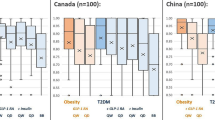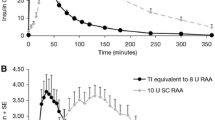Abstract
Background
In clinical trials, patients have expressed greater satisfaction with inhaled human insulin (EXUBERA®, Pfizer) than with injectable insulin. No studies to date have attempted to quantify the strength of preferences for these alternative routes of administration.
Objective
To elicit health state preference values from people with diabetes mellitus for treatment with inhaled human insulin compared with injectable insulin.
Study design
A patient preference study.
Methods
Written descriptions were developed for five clinical scenarios: two for type 1 diabetes and three for type 2 diabetes. Each scenario required adjustment or initiation of insulin treatment because of poor glycaemic control. Two alternative insulin regimens were described for each scenario: injectable-only or inhaled human insulin to replace or reduce the number of daily injections. Equal efficacy was assumed within each of these scenario pairs.
A total of 344 UK adults (66% male), 132 (mean age 49 years) with type 1 diabetes and 212 (mean age 63 years) with type 2 diabetes, rated scenario pairs corresponding to their own type of diabetes and rated their own health by time trade-off (TTO), by correspondence with EQ-5D health descriptions and on the EQ-5D visual analogue scale. Respondents stated their preference for, or indifference between, the injection-only or inhalation variant comprising each scenario pair. TTO utilities and EQ-5D utilities by UK community tariff were compared within each scenario pair, for the total sample rating, each scenario pair, and by subgroups of stated preference for each variant.
Results
A majority, ranging from 63% to 81% across the scenarios, preferred inhalation. Mean differences in TTO scores were 0.074, 0.076, 0.088, 0.053 and 0.043 for the five scenarios, respectively (p < 0.005 for all). Mean EQ-5D differences were 0.043, 0.029, 0.037, 0.020 and 0.021 for the five scenarios, respectively (p < 0.05 for scenarios 1 and 3), driven mainly by differences on the pain/discomfort dimension of the EQ-5D. Differences in favour of inhalation among those preferring inhalation, were greater than differences in favour of injections among those preferring injections. Mean self-rated health was similar between respondents with type 1 and type 2 diabetes, at 0.83 (TTO) and 0.75 (EQ-5D). The TTO was more sensitive than EQ-5D. Self-rated health by EQ-5D compared closely with reported values from the UK Prospective Diabetes Study (UKPDS).
Conclusions
This study highlights the utility differences that people with diabetes perceive between the prospect of inhaled and injected routes of insulin administration, even under the assumption of no difference in efficacy. These differences are magnified when the comparison in utility scores is between the majority who prefer the inhaled route and the minority who prefer the injectable route.











Similar content being viewed by others
Notes
The use of trade names is for product identification purposes only and does not imply endorsement.
On 18 October 2007, after this manuscript was accepted for publication, Pfizer announced that it would no longer be making EXUBERA® available beyond 16 January 2008.
We use this term for convenience. More correctly, ‘utility’ values should be termed ‘health state preference’ values unless they conform to strict axioms of expected utility theory, which rarely is so.
References
Gansslen M. Uber inhalation von insulin. Klin Wochenschr 1925; 4: 71
Newhouse MT. Tennis anyone? The lungs as a new court for systemic therapy. CMAJ 1999 Nov 16; 161 (10): 1287–8
Cefalu WT. Inhaled insulin: a proof-of-concept study. Ann Intern Med 2001 May 1; 134 (9 Pt 1): 795
Quattrin T, Belanger A, Bohannon NJ, et al. Efficacy and safety of inhaled insulin (Exubera) compared with subcutaneous insulin therapy in patients with type 1 diabetes: results of a 6-mo nth, randomized, comparative trial. Diabetes Care 2004 Nov; 27 (11): 2622–7
Skyler JS, Cefalu WT, Kourides I A, et al. Efficacy of inhaled human insulin in type 1 diabetes mellitus: a randomised proof-of-concept study. Lancet 2001 Feb 3; 357 (9253): 331–5
Skyler JS, Weinstock RS, Raskin P, et al. Use of inhaled insulin in a basal/bolus insulin regimen in type 1 diabetic subjects: a 6-month, randomized, comparative trial. Diabetes Care 2005 Jul; 28 (7): 1630–5
Cefalu WT, Skyler JS, Kourides I A, et al. Inhaled human insulin treatment in patients with type 2 diabetes mellitus. Ann Intern Med 2001 Feb 6; 134 (3): 203–7
Royle P, Waugh N, McAuley L, et al. Inhaled insulin in diabetes mellitus. Cochrane Database Syst Rev 2004; (3): CD003890
Cappelleri JC, Cefalu WT, Rosenstock J, et al. Treatment satisfaction in type 2 diabetes: a comparison between an inhaled insulin regimen and a subcutaneous insulin regimen. Clin Ther 2002 Apr; 24 (4): 552–64
Gerber RA, Cappelleri JC, Kourides I A, et al. Treatment satisfaction with inhaled insulin in patients with type 1 diabetes: a randomized controlled trial. Diabetes Care 2001 Sep; 24 (9): 1556–9
Rosenstock J, Cappelleri JC, Bolinder B, et al. Patient satisfaction and glycemic control after 1 year with inhaled insulin (Exubera) in patients with type 1 or type 2 diabetes. Diabetes Care 2004 Jun; 27 (6): 1318–23
FreemantleN, Blonde L, Duhot D, et al. Availability of inhaled insulin promotes greater perceived acceptance of insulin therapy in patients with type 2 diabetes. Diabetes Care 2005 Feb; 28 (2): 427–8
British National Formulary [online]. Available from URL: http://www.bnf.org [Accessed 2007 Jul 23]
Coffey JT, Brandle M, Zhou H, et al. Valuing health-related quality of life in diabetes. Diabetes Care 2002 Dec; 25 (12): 2238–43
Clarke P, Gray A, Holman R. Estimating utility values for health states of type 2 diabetic patients using the EQ-5D (UKPDS 62). Med Decis Making 2002; 22 (4): 340–9
Maddigan SL, Feeny DH, Johnson JA. Health-related quality of life deficits associated with diabetes and comorbidities in a Canadian national population health survey. Qual Life Res 2005 Jun; 14 (5): 1311–20
Maddigan SL, Feeny DH, Johnson JA. A comparison of the health utilities indices mark 2 and mark 3 in type 2 diabetes. Med Decis Making 2003 Nov; 23 (6): 489–501
Brown GC, Brown MM, Sharma S, et al. Quality of life associated with diabetes mellitus in an adult population. J Diabetes Complications 2000 Jan; 14 (1): 18–24
The MVH Group. The measurement and valuation of health: first report on the main survey. York: Centre for Health Economics, University of York, 1994
MVH Group. The measurement and valuation of health: final report on the modelling of valuation tariffs. York: Centre for Health Economics, University of York, 1995
Torrance GW. Measurement of health state utilities for economic appraisal. J Health Econ 1986 Mar; 5 (1): 1–30
Arnesen T, Trommald M. Are QALYs based on time trade-off comparable? A systematic review of TTO methodologies. Health Econ 2005 Jan; 14 (1): 39–53
Dolan P, Gudex C, Kind P, et al. The time trade-off method: results from a general population study. Health Econ 1996 Mar; 5 (2): 141–54
Gudex C, editor. Time trade-off user manual: props and self-completion methods. York: University of York Centre for Health Economics, 1994 [online]. Available at URL: http://www.york.ac.uk/inst/che/publications/publicationsbyyear.htm#1994 [Accessed 2007 Nov 20]
Diabetes UK. Diabetes in the UK 2004. London: Diabetes UK, 2004 [online]. Available from URL: http://www.diabetes.org.uk/document/reports/in_the_UK_2004.doc [Accessed 2007 Nov 20]
UK prospective Diabetes Study Group. Quality of life in type 2 diabetic patients is affected by complications but not by intensive policies to improve blood glucose or blood pressure control (UKPDS 37). Diabetes Care 1999 Jul; 22 (7): 1125–36
Kind P, Dolan P, Gudex C, et al. Variations in population health status: results from a United Kingdom national questionnaire survey. BMJ 1998 Mar 7; 316 (7133): 736–41
Kind P, Hardman G, Macran S. UK population norms for EQ-5D. Discussion paper 172. York: University of York Centre for Health Economics, 1999 [online]. Available from URL: http://www.york.ac.uk/inst/che/publications/publicationsbyyear.htm#1999 [Accessed 2007 Nov 20]
Bagust A, Beale S. Modelling EuroQol health-related utility values for diabetic complications from CODE-2 data. Health Econ 2005 Mar; 14 (3): 217–30
Stiggelbout AM, Eijkemans MJ, Kiebert GM, et al. The ‘utility’ of the visual analog scale in medical decision making and technology assessment: is it an alternative to the time tradeoff? Int J Technol Assess Health Care 1996; 12 (2): 291–8
Brazier J, Ratcliffe J, Salomon J, et al. Who should value health? In: Measuring and valuing health benefits for economic evaluation. Oxford: Oxford University Press, 2007: 112–7
Rutten-van Molken MP, Bakker CH, van Doorslaer EK, et al. Methodological issues of patient utility measurement: experience from two clinical trials. Med Care 1995 Sep; 33 (9): 922–37
Jansen SJ, Stiggelbout AM, Wakker PP, et al. Patients’ utilities for cancer treatments: a study of the chained procedure for the standard gamble and time tradeoff. Med Decis Making 1998 Oct; 18 (4): 391–9
Hayman J A, Fairclough DL, Harris JR, et al. Patient preferences concerning the trade-off between the risks and benefits of routine radiation therapy after conservative surgery for early-stage breast cancer. J Clin Oncol 1997 Mar; 15 (3): 1252–60
Morrisson GC, Neilson A, Malek M. Improving the sensitivity of the time trade-off method: results of an experiment using chained TTO questions. Discussion paper 98/22. Nottingham: University of Nottingham School of Economics, 1998
Stalmeier PF. Discrepancies between chained and classic utilities induced by anchoring with occasional adjustments. Med Decis Making 2002 Jan; 22 (1): 53–64
McNamee P, Glendinning S, Shenfine J, et al. Chained time trade-off and standard gamble methods: applications in oesophageal cancer. Eur J Health Econ 2004 Feb; 5 (1): 81–6
Methods for obtaining health state values: generic preference-based measuers of health and the alternatives. In: Brazier J, Ratcliffe J, Salomon JA, et al. Measuring and valuing health benefits for economic evaluation. Oxford: Oxford University Press, 2007
Freemantle N. NICE says no to inhaled insulin: what lessons should we learn? Pharmacoeconomics 2006; 24 (7): 627–9
Pfizer and Nektar reach agreement on Exubera® (press release; 2007 Nov 13) [online]. Available from URL: http://www.pfizer.com/news/press_releases/pfizer_press_releases.jsp [Accessed 2008 Jan 3]
Acknowledgements
J. Chancellor, S. Aballéa and S. Cure are employees of i3 Innovus (formerly Innovus); A. Lawrence and R. Sheldon are Directors of Accent. N. Marchant is an employee of Pfizer and J. Plun-Favreau was an employee of Pfizer when the study was conducted. i3 Innovus and Accent conducted this research under a research grant from Pfizer and Sanofi-Aventis. The sponsors were involved in defining the research questions, piloting of the questionnaire and reviewing the manuscript, as reflected in the authorship. However, the sponsors had no role in the main study implementation, analysis or reporting of results.
J. Chancellor directed the study, contributed to its design, developed the scenarios and drafted the manuscript. S. Aballéa designed the chained time trade-off, wrote the statistical analysis plan and supervized the analysis. A. Lawrence developed the questionnaires, and managed recruitment and fieldwork. R. Sheldon contributed to the study design, developed the fieldwork plan and directed the development of the computer-assisted personal interview procedures and the database creation and validation. S. Cure performed the statistical analyses and prepared the statistical reports. J. Plun-Favreau helped define the study objectives, recruited respondents for the pre-pilot exercise and facilitated recruitment for the main study. N. Marchant helped define the study objectives and clinical indications. All co-authors read, commented on and approved the final manuscript.
The authors would like to acknowledge the expert technical advice on preference measurement provided by Professor John Brazier of the University of Sheffield and Professor Martin Buxton of Brunel University, England.
Author information
Authors and Affiliations
Corresponding author
Electronic supplementary material
Rights and permissions
About this article
Cite this article
Chancellor, J., Aballéa, S., Lawrence, A. et al. Preferences of Patients with Diabetes Mellitus for Inhaled versus Injectable Insulin Regimens. Pharmacoeconomics 26, 217–234 (2008). https://doi.org/10.2165/00019053-200826030-00005
Published:
Issue Date:
DOI: https://doi.org/10.2165/00019053-200826030-00005




